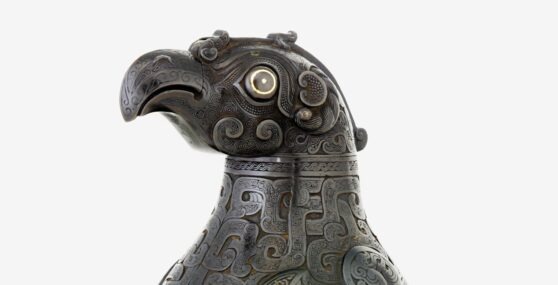Ongoing
-
Dates
-
Location
Freer Gallery of Art | Gallery 18
-
Collection Area
Chinese Art
The largest bronze foundry complex from antiquity was excavated at Houma in northern China in the mid-twentieth century. At the two-acre site, archaeologists discovered evidence of extremely sophisticated manufacturing techniques. Fragments of reused clay models, master pattern blocks, and decorated clay molds indicate the adoption of ceramic pattern transfers to cast ornamented bronze objects. Using pattern blocks to increase the speed and volume of production without sacrificing quality was an astonishing innovation. Their presence proves foundries at Houma operated with a specialized workforce and a division of labor.
The facility was established around 585 BCE by the rulers of the State of Jin, who remained its chief patrons for about 150 years. Houma produced ornamented objects with complex, abstract designs, inlay, and what is now considered to be the earliest pictorial narratives in China. More than half of the objects featured in this exhibition were made at Houma. Other pieces illustrate the factory’s long-lasting influence and legacy that extended into the Western Han period (206 BCE–9 CE).
Keep Exploring
-

Anyang: China’s Ancient City of Kings
February 25, 2023–April 28, 2024
- Jump To...
Explore All Pieces in this Section
Incense burner (shan lu) with cover
-
Period
Han dynasty
-
Geography
China
-
Material
Bronze
-
Accession
F1911.79a-b
Ritual wine container (hu) with masks
-
Period
Middle Western Zhou dynasty
-
Geography
China
-
Material
Bronze
-
Accession
F1913.21
Wine flask (bianhu) with geometric decoration
-
Period
Late Eastern Zhou dynasty, Late Warring States period
-
Geography
Henan or Hebei province, China
-
Material
Bronze with silver inlay
-
Accession
F1915.103a-b
Basin (jian) with narrative scenes
-
Period
Middle Eastern Zhou dynasty
-
Geography
China
-
Material
Bronze
-
Accession
F1915.107
Bowl with painted designs
-
Period
Han dynasty
-
Geography
China
-
Material
Bronze with pigment
-
Accession
F1916.239
Model for casting a monster mask
-
Period
Han dynasty
-
Geography
China
-
Material
Unglazed earthenware
-
Accession
F1918.144
Serving vessel with lid (dun) and dragons and ducks
-
Period
Eastern Zhou dynasty, Warring States period
-
Geography
Shanxi Province, China
-
Material
Bronze
-
Accession
F1932.13a-b
Chariot shaft fitting in the form of a dragon head
-
Period
Late Eastern Zhou dynasty, Late Warring States period
-
Geography
Jincun, Henan province, China
-
Material
Bronze with gilding and silvering and glass
-
Accession
F1932.14a-c
Terminal chock from a chariot
-
Period
Eastern Zhou dynasty, Warring States period
-
Geography
China
-
Material
Bronze with gold and silver inlay
-
Accession
F1932.15a-b
Terminal chock from a chariot
-
Period
Eastern Zhou dynasty, Warring States period
-
Geography
China
-
Material
Bronze with gold and silver inlay
-
Accession
F1932.16a-b
Basin (jian) with dragon interlace
-
Period
Middle Eastern Zhou dynasty
-
Geography
Huixian, Henan province, China
-
Material
Bronze
-
Accession
F1939.5
Lidded ritual food server (dou) with dragon interlace
-
Period
Late Eastern Zhou dynasty, early Warring States period
-
Geography
China
-
Material
Bronze with gold inlay
-
Accession
F1939.41a-b
Fitting in the form of an animal, possibly a tapir
-
Period
Middle Eastern Zhou dynasty
-
Geography
Shanxi province, China
-
Material
Bronze
-
Accession
F1940.23
Lidded incense burner (xianglu) with geometric decoration and narrative scenes
-
Period
Early Western Han dynasty
-
Geography
Henan or Hebei province, China
-
Material
Bronze with gold, silver, turquoise, and carnelian inlay
-
Accession
F1947.15a-b
Lidded ritual food cauldron (ding) with dragon interlace
-
Period
Middle Eastern Zhou dynasty
-
Geography
China
-
Material
Bronze
-
Accession
F1947.20a-b
Cup
-
Period
Eastern Zhou dynasty, Warring States period
-
Material
Lacquer
-
Accession
F1947.24
Fitting in the form of a quadruped with interlace
-
Period
Late Eastern Zhou dynasty, Warring States period
-
Geography
Liyu, Probably Shanxi province, China
-
Material
Bronze
-
Accession
F1948.24
Cup and stand
-
Period
Late Eastern Zhou dynasty, early Warring States period
-
Material
Black and red lacquer on wood core
-
Accession
F1949.1
Ewer of brownish lacquer over wood, representing a crouching animal
-
Period
Eastern Zhou to Western Han dynasty
-
Geography
China
-
Material
Lacquer
-
Accession
F1949.22
Bowl with decorations overlaid in red and dull brown lacquer
-
Period
Late Eastern Zhou dynasty, Warring States period
-
Geography
China
-
Material
Lacquer
-
Accession
F1953.8
Ritual wine container (zun) with masks and dragons
-
Period
Middle Western Zhou dynasty
-
Geography
China
-
Material
Bronze
-
Accession
F1954.122
Square ritual wine container (fanghu) with narrative scenes
-
Period
Middle Eastern Zhou dynasty
-
Geography
China
-
Material
Bronze
-
Accession
F1956.15
Ritual wine container (hu) with dragon interlace
-
Period
Middle Eastern Zhou dynasty
-
Geography
China
-
Material
Bronze
-
Accession
F1957.22
Lidded ritual wine container (zun) in the form of a bird
-
Period
Middle Eastern Zhou dynasty
-
Geography
Shanxi province, China
-
Material
Bronze with gold inlay
-
Accession
F1961.30a-b
Square lidded wine container (fanghu) with geometric decoration
-
Period
Late Eastern Zhou dynasty, Middle Warring States period
-
Geography
China
-
Material
Bronze with copper, silver, and malachite inlay
-
Accession
F1961.32a-b
Lidded ritual container (hu) with painted decoration
-
Period
Han dynasty
-
Geography
China
-
Material
Bronze
-
Accession
F1968.32a-b
Basin with painted decoration
-
Period
Han dynasty
-
Geography
China
-
Material
Bronze
-
Accession
F1968.33
Lidded food cauldron (ding) with painted decoration
-
Period
Han dynasty
-
Geography
China
-
Material
Bronze
-
Accession
F1968.34a-b
Lidded square ritual wine vessel (fanghu) with painted decoration
-
Period
Han dynasty
-
Geography
China
-
Material
Bronze
-
Accession
F1968.35a-b



